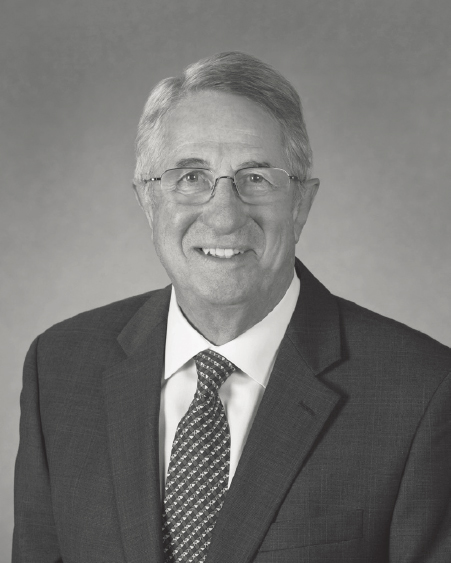

ROBERT W. GORE
1937–2020
Elected in 1995
“For the invention and commercialization of high-technology products, including Gore-Tex.”
BY BABATUNDE A. OGUNNAIKE AND ERIC W. KALER
ROBERT WALTON GORE, president and chair of the board of W.L. Gore and Associates, died September 17, 2020, at the age of 83 at his summer home in Earleville, Maryland.
He was born in Salt Lake City on April 15, 1937, the oldest of five children of Wilbert L. (Bill) and Genevieve W. (Vieve) Gore. His family soon moved to Delaware, where his father worked for the DuPont company and became interested in uses of polytetrafluoroethylene (PTFE) in industrial products; he left DuPont to form W.L. Gore and Associates in 1958.
Bob graduated from Newark High School in 1955 and went on to earn a bachelor of science degree (1959) at the University of Delaware (UD) and then a master’s (1961) and PhD (1963) at the University of Minnesota, all in chemical engineering. He had become a member of the board of directors of W.L. Gore and Associates in 1961, and in 1963 returned to Delaware to rejoin the company.
Bob’s technical successes came early and often. While a UD sophomore, he worked with his father to find a way to wrap wires and create insulated cables and harnesses using PTFE; Bob played a key role in solving the technical issues. This became the first product of W.L. Gore and Associates and helped launch the company. Bob became the technical director in 1967.
By 1969 the company sold several products in the wire and cable sector, had been a key supplier to the growing computer industry, and was a vendor for the Apollo space program. But there was strong motivation to reduce the cost of PTFE in their applications. This led to the idea of “expanded” PTFE, made by stretching PTFE tape. The challenge was that, under all conditions explored, the tape would stretch a bit but ultimately retract or break.
One evening, after trying for hours to coax a stretch, Bob gave a heated PTFE rod a sharp yank—and the rod stretched almost 1000 percent. That was the moment of creation of expanded PTFE, which provided the basis for Gore-Tex, the billion-dollar product that catapulted the company to an unprecedented level of success. Gore-Tex is now a household name, and the company has expanded to Gore Industrial Products and Gore Medical Products.
Bob became president and CEO of the company in 1976 and served until 2000. He stepped down as chair in 2016. He was not only a great inventor but also a fierce, yet kind, leader.
Terri Kelly, who succeeded Bob as president, observed that, “In addition to Bob’s numerous contributions to technology and innovation, he was known for his incredible business intuition, critical thinking skills, and willingness to challenge the status quo. He made significant contributions to the creation of new business tools and concepts, which were quite ingenious and simple in principle but created powerful organizational discipline. Throughout Bob’s career he was a mentor to so many, challenging you to explore things at a deeper level and always asking the most insightful questions.”
A superb practical engineer, “Bob was a master at finding the fastest way to test something,” according to Bret Snyder, chair of W.L. Gore and Associates and Bob’s nephew. Recognizing his uncle as a gifted leader, he continued, “One time Bob challenged a business unit leader on the mission of the business. After some questions and challenges from Bob, the next week the business unit leader came back with a single sentence that precisely and elegantly defined the mission, to Bob’s satisfaction. Bob didn’t allow intellectual laziness and confusion.”
Son Scott Gore remembers his father’s routine: “After the evening news, he would gather a large yellow pad of paper and pencil, his slide rule, and drafting tools such as a scale ruler, protractor, and compass. Sitting in front of the TV, he would design process machinery. My bedtime was 9:30 p.m., and often he was still working when I went to my room. Dad always tried to instill a sense of urgency. At some point he would inevitably want to know ‘What are you going to do this week, this month, this year?’”
Betty Snyder, Bob’s sister and a member of the board of W.L. Gore and Associates, recalls that her brother “was dedicated to discovering and acting on truth—scientific truth, customer truth, the true nature of a person, and the true nature of a group. This was his defining characteristic. He believed that proven facts are something you could hold on to. Good decisions could not be based solely on opinions.” She added that “Bob believed in trying hard. He himself tried to do his best in every effort—nothing was done in a mediocre way. When I recently asked him his advice to Associates, this was his response: ‘try hard.’ He believed that the accumulation of years of trying hard, no matter what the task at hand, result in significant personal development. And this was the case with him.”
Bob was committed to education and was a member of the board of directors of the UD Research Foundation and the UD board of trustees. He and his family were extraordinary philanthropists, giving generously to many organizations, including both UD and the University of Minnesota.
Bob and his family began their impactful support of UD facilities in the mid-1990s. After a conversation with then-president David Roselle about the need for more general-purpose classroom space on the campus, Bob agreed to contribute $15 million for such a building to fill the last empty space on the north Green. When the project cost climbed to $18.5 million, he was unwavering in his full support, and adamant that it should match the classic Georgian style of its neighboring buildings on the Green. The result was Gore Hall, the first new building on the Green in more than 35 years and home to 25 high-tech classrooms and other facilities.
The holder of nine US patents, Bob received many honors in recognition of his creativity and leadership, including the Society of Plastics Engineers John W. Hyatt Award for benefits to society through the use of plastics and the Perkin Medal for innovation in applied chemistry resulting in commercial development from the Society of Chemical Industry (American Section). He also was an active member of the American Chemical Society and the 2019 Carothers Award recipient (Delaware Section). He was elected to the NAE in 1995 and inducted into the US National Inventors Hall of Fame in 2006.
Bob leaves behind a large family, including his wife, Jane, sons Scott, Tom, and Brian and daughter Sharon; stepchildren Debi, Jayne, Jack, Tom, Chris, and Steve; sisters Susan, Ginger, and Betty, and brother Dave; 28 grandchildren; and 13 great-grandchildren.






